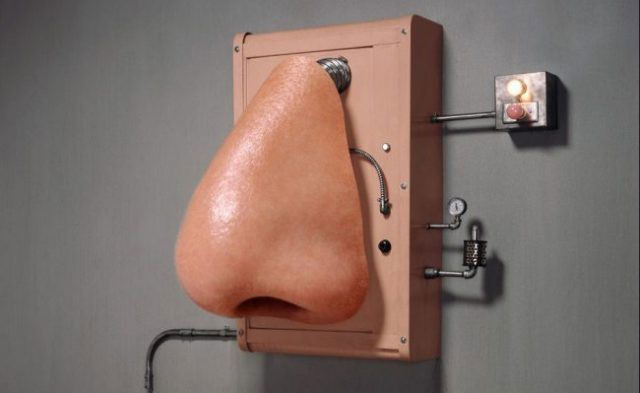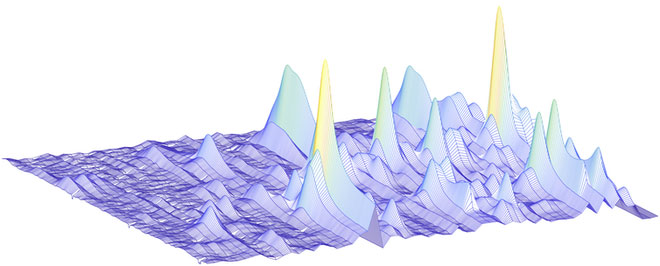Artificial intelligence can smell your breath to detect cancer
It can be widely used in medicine, forensics, environmental analysis and many other areas.
Best known for the ability to look (like in unmanned cars, face image recognition technology), hearing ability (like Alexa and other virtual assistants). And starting now, you will know that artificial intelligence can also smell.
A group of scientists in the UK is developing an AI system that can smell people's breaths to diagnose disease.

These machines, called gas chromatography mass spectrometry (GC-MS).
Animals, even some plants, are able to sense scents to identify hundreds of different compounds floating in the air. But compared to other animals, people's sense of smell is less developed and definitely not used regularly every day.
For that reason, people are not aware of the abundance of forms of information that can be transmitted through the air with scents, which can only be felt by a particularly sensitive olfactory system. But with AI help, we can change that.
From a few decades ago, world chemical laboratories were able to use machines to detect very small amounts of airborne substances. These machines, known as gas chromatographic mass spectrometry (GC-MS) , can analyze air to discover thousands of different molecules called volatile organic compounds.
In the GC-MS, each compound from an air sample is separated, then smashed into pieces, creating a special trace from which they can be identified. The image below will let you visualize a small piece of data from analyzing the air sample as a human breath:

Each vertex on the figure represents a piece of a molecule.Models with such peaks show the presence of individual substances.Often even the smallest peak can play a very important role.
Among the hundreds of compounds in human breaths, some of them may reveal the presence of some type of cancer, even at an early stage. Therefore, laboratories around the world are testing the GC-MS as a non-invasive diagnostic tool, to identify a variety of diseases in a timely manner without causing pain.
Unfortunately, this process can be very time consuming. Large amounts of data need to be manually checked and analyzed by experts. A large number of compounds and complexity of data make us spend a lot of time just analyzing a single breath pattern. And even experts sometimes make mistakes, they may miss a compound or confuse it with another compound.
Artificial intelligence can smell
With the idea of using artificial intelligence to do that on behalf of scientists, a data research team at Loughborough University, the United Kingdom is developing an AI system that can sense and learn about Chemical compound in the breath sample.
Math models are inspired by what happens inside the brain, called deep learning, specifically designed to "read" the trace in your breath.
A group of doctors, nurses, radiologists and medical physicists at the Edinburgh Cancer Center collected breath samples from their patients. The sample is then analyzed by two groups, on one side are chemists and the other is computer scientists.
Once chemists manually identified a compound in the patient's breath sample, it was turned into data to re-teach the deep learning network of the AI side of computer scientists. Calculations are accelerated by special devices, called GPUs, that can handle different pieces of information at the same time.
Deep learning networks are constantly trained from the breath samples it analyzes, from there, they are progressing, until it is possible to identify the specific chemicals in the breath sample. need chemists.

The artificial intelligence model identifies the breath.
In this first study, AI was directed to focus on recognizing a group of chemicals, called aldehydes , that often appear in the breath of stressed patients or ordinary people.
Computers equipped with AI technology only take a few minutes to automatically analyze a breath pattern that an expert previously had to take at least a few hours to perform. Because of its performance, AI makes the whole breath analysis process cheaper - but above all it makes analysis more reliable.
Even more interesting, with deep learning, AI can acquire more knowledge and improve its accuracy over time, as it analyzes more patterns. As a result, this method is not restricted to any particular substance, meaning it has the ability to smell everything.
Artificial intelligence is trained to detect even a small number of volatile compounds, which can be widely used in medicine, forensics, environmental analysis and many other areas. If an AI system can detect signs of illness, then it can also do diagnosis and prescribing work as a doctor.
But perhaps, we should only use AI as a tool to detect airborne substances. It is not necessary for us to listen to the diagnosis of AI or to depend on them to make decisions. The final conclusions should probably still be made by humans.
- Use artificial intelligence to detect cancer for only $ 1
- Diagnosis of cervical cancer faster by artificial intelligence
- Breath tests can detect breast cancer
- Artificial intelligence will contribute to defeating cancer
- Diagnosis of lung cancer through ... breath odor
- Japan develops robot to detect bad breath, foot odor
- Artificial intelligence of Google can detect cancer
- An effective way to eliminate alcohol smell in your breath
- It was possible to test 8 types of cancer and 9 other diseases with just one breath
- Artificial Intelligence detects 85% of network attacks, becoming smarter
- IBM's artificial intelligence invented new perfumes
- Artificial intelligence predicts the progress and spread of cancer
 The world's first sexless AI voice
The world's first sexless AI voice This cool t-shirt will make you invisible to AI
This cool t-shirt will make you invisible to AI AI can predict personality only through selfie photos
AI can predict personality only through selfie photos The world-famous chess player lost to Golaxy before, artificial intelligence 'made in China'
The world-famous chess player lost to Golaxy before, artificial intelligence 'made in China' Which animal can hold its breath the longest?
Which animal can hold its breath the longest?  Why does halitosis always appear when you wake up?
Why does halitosis always appear when you wake up?  Is it possible to 'fool' the alcohol meter?
Is it possible to 'fool' the alcohol meter?  Unexpectedly, breathing exercises can save a lot of cancer patients
Unexpectedly, breathing exercises can save a lot of cancer patients  How to cure hiccups immediately at home
How to cure hiccups immediately at home  The strange parts of the body still saved by the great men
The strange parts of the body still saved by the great men 